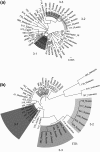Classification of infectious bursal disease virus into genogroups
- PMID: 28825213
- PMCID: PMC5671532
- DOI: 10.1007/s00705-017-3500-4
Classification of infectious bursal disease virus into genogroups
Abstract
Infectious bursal disease virus (IBDV) causes infectious bursal disease (IBD), an immunosuppressive disease of poultry. The current classification scheme of IBDV is confusing because it is based on antigenic types (variant and classical) as well as pathotypes. Many of the amino acid changes differentiating these various classifications are found in a hypervariable region of the capsid protein VP2 (hvVP2), the major host protective antigen. Data from this study were used to propose a new classification scheme for IBDV based solely on genogroups identified from phylogenetic analysis of the hvVP2 of strains worldwide. Seven major genogroups were identified, some of which are geographically restricted and others that have global dispersion, such as genogroup 1. Genogroup 2 viruses are predominately distributed in North America, while genogroup 3 viruses are most often identified on other continents. Additionally, we have identified a population of genogroup 3 vvIBDV isolates that have an amino acid change from alanine to threonine at position 222 while maintaining other residues conserved in this genogroup (I242, I256 and I294). A222T is an important mutation because amino acid 222 is located in the first of four surface loops of hvVP2. A similar shift from proline to threonine at 222 is believed to play a role in the significant antigenic change of the genogroup 2 IBDV strains, suggesting that antigenic drift may be occurring in genogroup 3, possibly in response to antigenic pressure from vaccination.
Conflict of interest statement
Conflict of interest
All the authors declare that they have no conflict of interest.
Ethical approval
This article does not contain any studies with animals performed by any of the authors.
Figures



References
MeSH terms
Substances
LinkOut - more resources
Full Text Sources
Other Literature Sources

